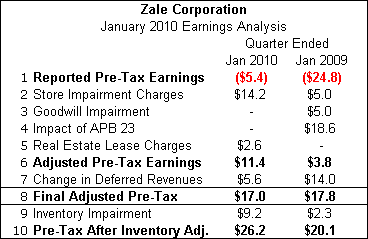IDEX Online Research: Read Fine Print for Zale’s Full Financial Story
March 07, 10
Zale’s financial press release for the three-month period ended January 2010 didn’t provide nearly enough insight about the company’s core performance for the casual reader who takes only a quick glance to get the “bottom line” picture. Zale’s financials included adjustments that, at first glance, might suggest that Zale’s financial condition is better than reality.
We’re not suggesting that its financials were misleading: it reported results under U.S. GAAP accounting and SEC regulations. However, GAAP accounting allowed Zale to report a $6.7 million after-tax profit for the January 2010 quarter, even though it had a pre-tax loss of about $5.4 million. We’d argue that FASB (the Financial Accounting Standards Board) slipped up when it agreed to sanction this kind of accounting.
January Quarter Financial Results
The table below summarizes the most meaningful financial data. We have omitted the usual “net profit” information because it is not meaningful. But, even the data on the table below requires some adjustments and explanation.

So what really happened in the quarter ended January 2010? It is more difficult than ever to dissect Zale’s financials from the company’s press release. Historically, the company has provided more detail; now, it seems to provide less detail, though management is still meeting the “letter of the law” concerning what must be reported.
Full financial details will follow in legal documents, but they are currently not available. Further, the company made adjustments (unexplained, so far) to the prior year’s financials, though they were modest.
Here’s our analysis of the likely pre-tax results for Zale after adjustments.

Source: Company Reports
Using numbers from Zale’s publicly available documents, we could make the argument that its pre-tax results this year – a profit of $17.0 million – were worse than last year’s pre-tax results $17.8 million. Or, we could make the case that its pre-tax earnings for the January quarter were moderately better than last year (line 10) or that its pre-tax earnings were dramatically better this year (line 6).
Here’s the basic problem with reversing all of these “special” adjustments. We question just how “special” they really are. For example, take “inventory impairment” adjustments: that should be an on-going business cost, because retailers should melt slow moving inventory or price it below cost. While this year’s $9.2 million adjustment was dramatically above last year’s $2.3 million adjustment, should it be called out as “special”? It tells us that there was a lot more “bad” inventory in the mix this year. That is a normal cost of doing business when bad merchandise decisions are made.
While we could argue all day about which of these costs are “normal” and which are “special,” we have attempted to explain the various adjustments which management cited. And, we’ll try to answer the question, “Are they meaningful?”
· Store Impairment Charges – Companies can write down the value of under-performing assets, using U.S. GAAP, but only when there is no real hope of recovery, either related to operational performance or the value of the asset (real value plus goodwill). We’d argue that this is an on-going cost for retailers, but U.S. GAAP lets merchants break out those costs. Based on weak sales in the quarter, Zale management apparently identified a significant number of under-performing stores (probably all with negative cash flow at the store level). In its conference call, management said it closed 24 stores. These are not likely the stores that were impaired in the quarter ended January, so we’d predict that there are more store closings coming.
· Goodwill Impairment – When a company pays more than fair market value for an asset, the excess over fair market value is deemed to be “goodwill.” In the prior year’s quarter, Zale wrote down some goodwill since it was determined that the value of the goodwill would not likely be recoverable in future periods. The company apparently wrote no goodwill off in the most recent quarter, but it still has more than $96 million of goodwill on its balance sheet, based on October 2009 financials.
· APB 23 – This unusual adjustment in the prior year’s quarter relates to investing foreign earnings (from its Canadian operations) back into its Canadian facilities and operations. Normally, this would not be an issue. But apparently, Zale’s lenders refused to make loans against assets related to its foreign operations, if part of the funding of those assets was covered by tax deferments related to APB 23. It is a very complicated, technical part of the tax code; we believe nervous banks essentially forced Zale to revoke APB 23.
· Real Estate Lease Charges – These charges in the most recent quarter likely relate to store closings, but it is not clear. Most likely, these are payments to landlords to buy out store leases so some Zale stores can be closed.
· Changes in Deferred Revenues – This charge relates to a change in the accounting for Zale’s product warranty operations. Over time, this charge will more or less disappear, depending on circumstances. It is not particularly meaningful in determining Zale’s operational and financial success.
· Merchandise Impairment Charge – Zale’s reported gross margin was 49.8 percent for the quarter ended January 2010, up from 44.0 percent in the prior year. After adjusting for inventory impairment in both years, the actual gross margin was 51.3 percent this year versus 44.3 percent last year. However, as we have already noted, this just means there was more “bad” inventory this year versus the prior year.